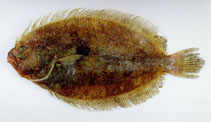| Family: |
Paralichthyidae (Large-tooth flounders) |
| Max. size: |
35 cm SL (male/unsexed) |
| Environment: |
demersal; marine; depth range 22 - 38 m, amphidromous |
| Distribution: |
Indo-West Pacific: Persian Gulf and off India (from Bombay southward to Sri Lanka) eastward to western New Guinea and southern China (Ref. 9774). |
| Diagnosis: |
Dorsal spines (total): 0-0; Dorsal soft rays (total): 67-76; Anal spines: 0-0; Anal soft rays: 51-56. Body brownish, a distinct, large dark blotch at junction of straight and curved parts of lateral line and a smaller blotch on middle of straight section of lateral line, many dark rings scattered on body. Upper profile of head without notch in front of eye. Scales on eyed side ctenoid on anterior part and dorsal and ventral margins of body on eyed side, cycloid on remaining areas. Pectoral fin on ocular side with 11-12 soft rays (Ref 9774).
Description: Characterized further by having small teeth on jaws with slightly enlarged teeth anteriorly; capable of rapid color changes, often flashing row of large pale patches along dorsal and ventral margins of body; median fins usually with faint, large dark spots (Ref. 90102). |
| Biology: |
Inhabits shallow continental shelves with muddy and sandy substrates. Feeds on benthic animals. Marketed mostly fresh. |
| IUCN Red List Status: |
Least Concern (LC); Date assessed: 10 March 2021 Ref. (130435)
|
| Threat to humans: |
harmless |
Source and more info: www.fishbase.org. For personal, classroom, and other internal use only. Not for publication.
